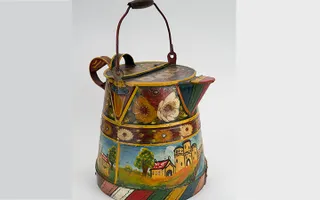A cutting-edge 3D rendering technique, known as photogrammetry, is helping us bring history to life at the National Waterways Museum in Cheshire.
We caught up with our collections team to find out more.
With nearly 20,000 recorded artefacts, the National Waterways Museum at Ellesmere Port boasts the largest inland waterways collection in the world. While it’s always been our mission to make these wonderful objects as accessible as possible, with such a huge catalogue, many never see the light of day. That could all change, with a brand-new initiative made possible thanks to the generous support from players of People's Postcode Lottery.
The project, spearheaded by our collections team at Ellesmere Port, employs a state-of-the-art process, ‘photogrammetry’, to create 3D images of the artefacts. Volunteer Chris Bacon, who’s been with the project from day one, explains: “You photograph the object from the top, sides, bottom, etcetera, capturing it from multiple angles, then feed the images into a sophisticated software suite. The software finds common points in the images and stitches them all together.”
The finished article is a high-quality 3D image, which can be made available online and enjoyed by canal enthusiasts across the world.
“It allows people to see our artefacts in a completely different light,” says collections officer, Georgina Wilson-Williams, who first conceived the idea after attending a photogrammetry workshop at the University of Liverpool. “The 3D models are a very tactile way for people to engage with these objects and discover the stories behind them; they can rotate them, enlarge them, and view them from every angle. It’s almost like picking up the artefact and turning it over in your hands.”
The groundbreaking project is still very much in its infancy, and rendering fragile, historic objects can be tricky. In one instance, it took nearly 50 hours to capture a single canal token, because of the item’s intricate design.
Yet, despite a few teething problems, the first collection of 3D images is already available to view online. The inaugural ‘Roses and Castles’ collection, which showcases the vibrant canal folk art that adorned 19th-century narrowboats, includes a number of beautifully decorated items, such as cabin stools and milk jugs.
“That was a big milestone,” says Georgina, “we wanted to start sharing our models with the public, but we didn’t want to just display random artefacts, we wanted to create a theme, and ‘Roses and Castles’ is a big favourite.”
The team are already working on their next collection, the intriguingly named, ‘What Lies Beneath’, which will showcase historic objects that have been retrieved from the canal bed. So far, Georgina and her colleagues have created 3D images of a firehose nozzle, a bone pipe, an inkpot, and a discarded Luger pistol.
Going forward, the team are keen to explore the possibilities of 3D printing, creating physical replicas of our most precious and fragile objects, so visitors can actually get their hands on history. “It would be great for our education visits and our visually impaired patrons,” says Georgina. “Visitors would actually be able to touch and feel the objects and almost step into the shoes of the working boat people that used them.”
For now, the pioneering art of photogrammetry is helping us breathe new life into our beautiful artefacts, giving canal enthusiasts everywhere the chance to enjoy our collection and immerse themselves in the history of our waterways.
Last Edited: 13 March 2024




